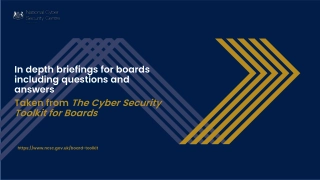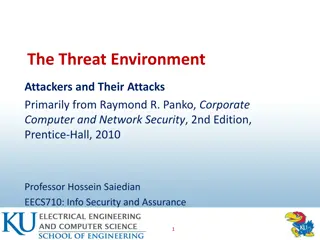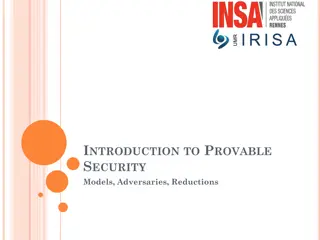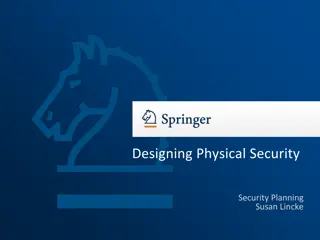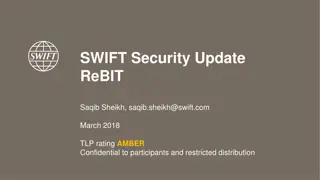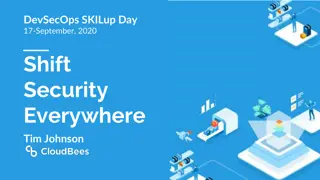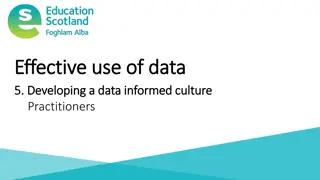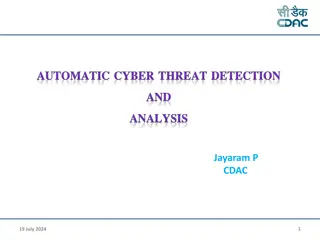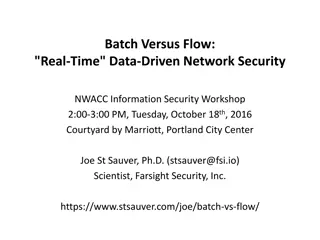Building a Security Culture: Strategies and Case Studies
Explore insights shared by industry experts on establishing a security culture within organizations, including building buy-in from founders, integrating threat modeling, leveraging secure frameworks, and learning from real-life case studies like Cross-Site Scripting (XSS) vulnerabilities and prevention techniques.
Download Presentation

Please find below an Image/Link to download the presentation.
The content on the website is provided AS IS for your information and personal use only. It may not be sold, licensed, or shared on other websites without obtaining consent from the author. Download presentation by click this link. If you encounter any issues during the download, it is possible that the publisher has removed the file from their server.
E N D
Presentation Transcript
Welcome Frank H. Wu Chancellor and Dean, UC Hastings College of Law
Introductory Remarks Tom Dahdouh Regional Director, Federal Trade Commission
Opening Remarks Chairwoman Edith Ramirez Chairwoman, Federal Trade Commission
Starting up Security Building a Security Culture
Featuring Devdatta Akhawe, Security Engineer, Dropbox Jonathan Carter, Project Lead, OWASP Mobile Top Ten Frank Kim, Chief Information Security Officer, SANS Institute Window Snyder, Chief Security Officer, Fastly Moderator: Laura Riposo VanDruff, Division of Privacy and Identity Protection, FTC
Building a Security Culture Founder Buy-In Founders and executives as security champions Building Security Expertise Engineers with interest can become security evangelists Leveraging the Security Community OWASP, BSides, SANS, and other free and proprietary resources ntegrating Threat Modeling Consider potential threats early ing Secure Frameworks Don t reinvent the wheel: platforms often provide secure APIs Consider building secure abstractions for your developers
Cross-Site Scripting (XSS) Case Study High-risk, easy to exploit vulnerability 1. Victim visits your organization s vulnerable page 2. Hacker injects malicious software into page 3. Victim executes this malicious software on their own machine Why is XSS bad news for your customers? Hacker s malicious software typically: Steals sensitive information about the user Does things on behalf of the user they didn t authorize Injects malware / adware / spyware onto victim s machine
How to Identify and Prevent XSS Risks Are you vulnerable? Ask yourself: 1. Is your server receiving data (even hidden data) that is coming from the user s web browser? Inspect and verify every piece of data before you trust it in your own systems. 2. Are you sending data coming from your server to the user s web browser? HTML Encode that data before you send it to the user s browser. HTML Encoding prevents malicious software from being executed on the user s machine. Consult the OWASP XSS Prevention Cheat Sheet
How does training help prevent XSS? Training serves very important functions: 1. Identify underlying assumptions and planned inputs coming from users. 2. Think like a hacker by providing unexpected inputs. Observe how the system responds. 3. Eliminate flaws during the design / implementation stages before a hacker has a chance to find them in a production environment.
Building a Security Culture Founder Buy-In Founders and executives as security champions Building Security Expertise Engineers with interest can become security evangelists Leveraging the Security Community OWASP, BSides, SANS, and other free and proprietary resources Integrating Threat Modeling Consider potential threats early Using Secure Frameworks Don t reinvent the wheel: platforms often provide secure APIs Consider building secure abstractions for your developers
Scaling Security Adapting Security Testing for DevOps and Hyper-Growth
Featuring Michael Coates, Trust and Information Security Officer , Twitter Zane Lackey, Founder and Chief Security Officer, Signal Sciences Jeff Williams, Founder and Chief Technology Officer, Contrast Security Moderator: Laura Berger, Division of Privacy and Identity Protection, FTC
Scaling security Start with the basics Harness existing resources Make security visible Automate testing and feedback Streamline feedback (and send it to the right people) Detect risky changes/features
Investing in Security Accel Partner Arun Mathew FTC Chief Technologist Ashkan Soltani
Bugs and Bounties Vulnerability Disclosure and Response
Featuring Raymond Forbes, Security Engineer, Mozilla Paul Moreno, Security Engineering Lead, Pinterest Katie Moussouris, Chief Policy Officer, HackerOne Moderator: Nithan Sannappa, Division of Privacy and Identity Protection, FTC
Develop Bug Disclosure Policy & Capability to Receive Bug Reports Develop Bug Handling Policy & Organizational Framework Response Identify Bug Internally Receive Bug Report Disclosure Verify Bug Acknowledge Receipt Bug Inform Bug Reporter Verified? No Yes Release Security Update Develop Security Update Adapted from Katie Moussouris, RSA 2013 presentation 'Application Security Response: When Hackers Come A-Knockin http://www.rsaconference.com/events/us13/ agenda/sessions/122/application-security- response-when-hackers-come-a Improve SDLC
Bug Response 101 Roll out the red carpet security@company.com (+ PGP key) company.com/security Bug Verification Steps Initial Investigation Root Cause Analysis Communicate Bug Reporters Customers Improve SDLC Training Design Industry Guidelines ISO 29147 Vulnerability Disclosure ISO 30111 Vulnerability Handling Processes
1995 2002 A Non-Exhaustive History of Bug Bounties 2004 2015 2012 2005 2010 2013 2014 2011 2007
Bug Bounties No One Size Fits All Scope What domains, apps, versions (e.g., beta) are in scope? What types of bugs are in scope? Incentives Cash Swag Hall of Fame Time & Resources Expect an initial ramp-up Consider outsourcing
Beyond Bugs Embracing Security Features
Featuring Pierre Far, Product Manager, Google Jon Oberheide, Co-founder and Chief Technology Officer, Duo Security Yan Zhu, Security Engineer, Yahoo! Moderator: Jessica Lyon, Division of Privacy and Identity Protection, FTC
Embracing Security Features Implement as soon as you can; it only gets harder with time Optimize and configure smart and security features won t slow down or break your product Take advantage of tools that can automate the process Put metrics to work for you
Subscribe to the FTC Business Blog business.ftc.gov/blog






